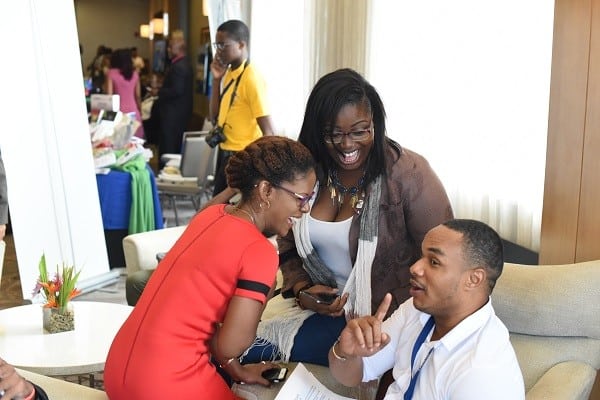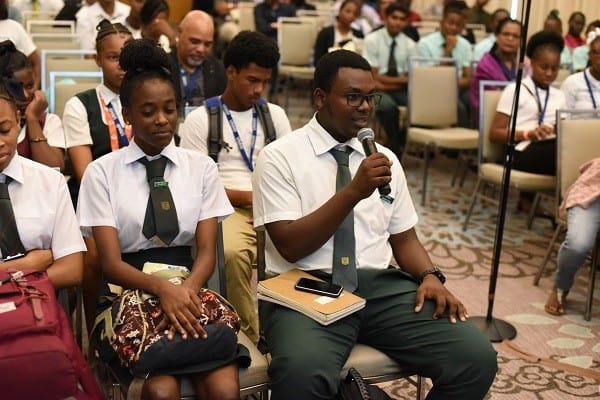Caribbean youth create blueprint for violence prevention
By Evelyn RupertMarch 12, 2019
To reduce violence across the Caribbean and foster a “culture of peace,” youth must be meaningfully engaged as leaders, say youth from across the region in a draft agenda for advocacy and action.
The draft Caribbean Youth Advocacy and Action Agenda on Violence Prevention (AAA) was developed by a group of about 20 youth from the region, with the input of hundreds more. The Agenda lays out a youth-centric plan for preventing violence and highlights several successful programs that can serve as models.
“We as young people cannot sit idly by and expect our governments to do everything. We must all work together to build a culture of peace and prosperity within our Caribbean communities.”
The draft AAA was shaped by additional feedback given by participants at the Caribbean Summit on Youth Violence Prevention, which took place Jan. 15-16 in Georgetown, Guyana.
The Steering Committee for the Learning for Youth Networking and Change Sessions (LYNCS), a regional learning network focusing on youth-centered violence prevention, worked on the AAA over the course of several months, hosting webinars, youth dialogues, and surveys to collect a wide range of youth perspectives and ideas.
“This Action and Advocacy Agenda represents us as young people throughout the Caribbean region,” remarked LYNCS Co-Chair Kurba-Marie Questelles at the Summit’s opening ceremony. “We as young people cannot sit idly by and expect our governments to do everything. We must all work together to build a culture of peace and prosperity within our Caribbean communities.”
LYNCS was supported by the U.S. Agency for International Development (USAID) under the aegis of its Community, Family and Youth Resilience program (CFYR) and CARICOM, a regional organization dedicated to cross-country integration and fostering resilience.
The Advocacy and Action Agenda builds upon CARICOM’s Social Development and Crime Prevention Action Plan, which has been accepted as the overarching regional framework to guide violence prevention and reduction. The AAA centers on three of CARICOM’s core pillars: prevent and reduce crime; foster social inclusion; and promote reintegration.
“That Agenda identifies a pathway to develop a culture of peace,” CARICOM Secretary-General Ambassador Irwin LaRocque said of the AAA. “This initiative and the process through which it has been defined is an excellent illustration of the commitment of our youth to play their part and be leaders in the development of our community.”
The following are the three major takeaways from the youth-driven Action and Advocacy Agenda:
Prevent and reduce crime
The youth behind the Action and Advocacy Agenda call on policymakers and donors to support crime and violence prevention programs that are comprehensive, culturally responsive, and inclusive and that are designed at the local level with youth engagement throughout the process.
Most victims and perpetrators of crime in the Caribbean are males ages 15 to 30 years old, according to an Inter-American Development Bank report from 2017. The Advocacy and Action Agenda highlights the importance of addressing how toxic masculinity fuels crime, gender-based violence, bullying, and inter-family violence.
Another common theme that emerged through the authors’ conversations with youth was the need to end corporal punishment, both in the home and at school, to build more peaceful communities and stop cycles of violence repeated by different generations.

The document encourages scaling-up and supporting evidence-informed programs built on positive youth development: an approach and philosophy that empowers youth to reach their potential with support from families, communities and governments.
Programs like the RISE Safe Spaces initiative are already making a difference in their communities, says Questelles. They just need the backing and resources to expand and share their best practices across the region.
“The reality is that many young persons throughout the Caribbean have been working on outstanding projects in silos within their various communities,” Questelles said. “With the introduction of the LYNCS and, by extension, the AAA, these projects can be upscaled and shared via this regional mechanism through which every Caribbean citizen can learn, share ideas and provide assistance.”
Foster social inclusion
In the Caribbean and around the world, large numbers of youth are socially excluded and discriminated against on the basis of their gender, gender identity, sexual orientation, race, ethnicity, disability, socioeconomic status, and more.
To reduce violence, it’s imperative to promote programs that are inclusive and increase marginalized groups’ dignity, security and opportunity, the Agenda emphasizes.
The AAA calls for resources to support equitable educational and economic opportunities. Specifically, the document urges governments to support youth entrepreneurship and employment and address inequality in education with teacher training, counseling, vocational training, social-emotional development curricula, and programs to support parents.
Systems that foster bias and marginalization need to be dismantled so that every young person has the opportunity to play a role in decision-making.

Promote reintegration
The third pillar of the Advocacy and Action Agenda centers on rehabilitation and reintegration of youth who have come into conflict with the law.
For the AAA’s authors, this means justice systems across the region must not treat youth offenders in the same manner as adults and should be better informed about youth development. Laws and policies must be tailored more toward meeting the unique needs of young people beginning at the time of arrest, not release, and providing youth with the requisite support needed to prevent them from becoming repeat offenders.
Reintegration of perpetrators and restorative justice, which ultimately aims to rehabilitate criminal offenders through reconciliation work, are essential for communities to heal from the effects of crime and violence, the agenda states.
“If the criminal justice system aided those whom it imprisoned and provided them with the necessary tools to be appropriately reintegrated, we would be better off as a Caribbean society,” Questelles said.
Young people across the Caribbean face many challenges. But too often, the AAA asserts, they are seen only for those challenges, and not as part of the solution.
The Caribbean Summit on Youth Violence Prevention gave youth a chance to provide inputs to the Action and Advocacy Agenda and by extension to shape policy and programming related to violence. This is in keeping with USAID’s approach to sustaining program outcomes far beyond the life of the project by engaging local partners, building their capacity and providing them with the tools to foster local solutions.
“It’s about getting down and dirty. It’s about going back to your communities and showing that you have a plan of action,” said Vishal Hulbert Joseph, LYNCS Steering Committee member and Summit Master of Ceremonies. “[It’s about] showing how you will promote this Agenda within your community to affect the real positive change.”
Click here to read the full Caribbean Youth Advocacy and Action Agenda on Violence Prevention.

